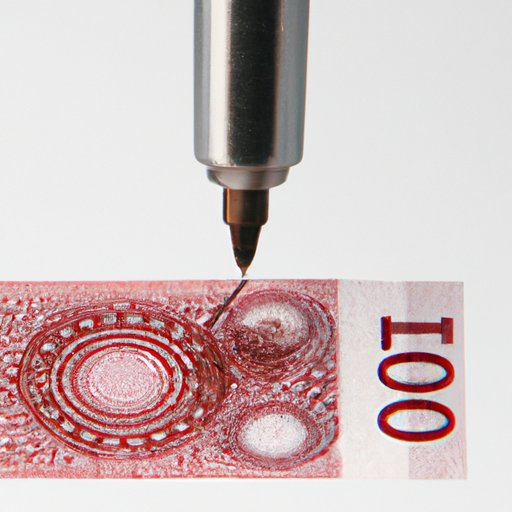
Introduction
It can be easy to accidentally accept counterfeit money, especially if we are not aware of the different methods to identify fake bills. Being able to distinguish between genuine and fake money is important to prevent monetary loss and legal consequences. Counterfeit bills can harm both individuals and businesses, which is why it’s crucial to learn how to tell if money is fake.
Hold the Bill Up to the Light
One simple and effective way to identify counterfeit bills is to hold them up to the light. All genuine US bills include two security features that counterfeiters often have difficulty replicating: watermarks and security threads. Watermarks are faint images of the portraits on the bill, which can be seen when held up to light. Security threads are thin strips embedded in the paper and can be seen as a thin line on the left side of the bill when held up to light. By examining these features, we can identify genuine bills from fake ones.
Counterfeit Detection Pen
Another widely used method to detect counterfeit bills is the counterfeit detection pen. The pen uses a chemical reaction to detect the type of paper used in the bill. If the bill is genuine, the pen will not leave a mark, but if it’s fake, it will turn black or brown. However, it’s essential to note that this method is not always accurate since some counterfeiters use acid-free paper to bypass the pen’s detection. Therefore, it’s important to use a pen in conjunction with other methods of detection.
Texture of the Paper
Genuine bills also have a unique texture that counterfeiters have difficulty matching. If you run your fingers over a genuine bill, you will feel slightly raised ink on the portraits and letters. You can also see the texture when you tilt the bill. Counterfeit bills are often printed on low-quality paper, making it difficult to match the texture of genuine bills. By feeling the texture, we can identify counterfeit bills from genuine ones.
Small, Intricate Details
Microprinting and raised lettering are two small and intricate details that genuine bills have to make it difficult for counterfeiters to replicate. Microprinting is tiny writing on the bill that can only be seen under a magnifying glass, while raised lettering on the Federal Reserve and Treasury seals can be felt when you run your fingers over them. By locating and identifying these details, we can distinguish between genuine and counterfeit bills.
Rubbing Test
The rubbing test is another way to identify counterfeit money. This method involves rubbing the bill gently on a piece of paper. Genuine bills are printed with high-quality ink, while counterfeiters often use low-quality ink that smudges or transfers onto the paper. If the bill leaves smudges or ink on the paper, it’s likely fake. If not, it’s probably genuine. However, it’s essential to note that this method is not always accurate since some counterfeiters use high-quality ink to bypass detection. Therefore, it’s crucial to use this test in conjunction with other methods.
Portrait on the Bill
The portrait on the bill is another essential feature that can help us identify counterfeit money. The portrait on the bill should match the corresponding figure on the Federal Reserve’s website. It’s crucial to check the website and compare the portraits to ensure they match and are not distorted. By doing so, we can identify counterfeit money just by checking the portraits.
Weight of the Bill
The weight of the bill is also crucial when identifying counterfeit money. Genuine bills are printed on specially made paper that has a particular weight. If the bill feels too light or too heavy, it’s likely fake. You can compare the weight of the bill to a genuine one or use a scale to determine whether it’s genuine or counterfeit.
Conclusion
In conclusion, identifying counterfeit money is crucial to prevent monetary loss and legal consequences. By using various methods such as holding the bill up to the light, using a counterfeit detection pen, feeling the texture of the paper, examining small, intricate details, performing the rubbing test, checking the portrait on the bill, and weighing the bill. It’s important to be vigilant and careful when handling money to protect ourselves and our businesses from counterfeiters.




